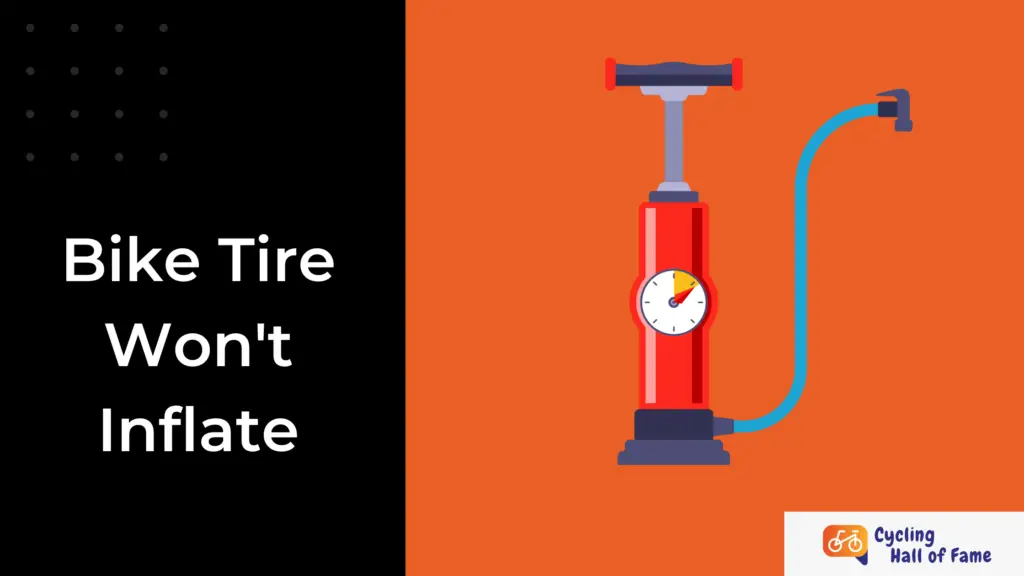It’s a perfect day for a bike ride – the sun’s shining, there’s a gentle breeze, and you’ve got the open road calling your name.
But just as you’re about to saddle up, you notice your bike tire stubbornly refuses to inflate. Sound familiar?
It’s a common hiccup for cyclists, but it doesn’t have to ruin your day. The key to dealing with this situation is understanding what’s going on.
This blog post will demystify why your bike tire won’t inflate and arm you with practical, easy-to-follow solutions.
Advertising links are marked with *. We receive a small commission on sales, nothing changes for you.
Key Takeaways

- Ensure you’re using the correct pump head compatible with your bike’s valve type, with a straight, firm connection on the valve stem.
- Check the valve stem for any signs of damage or blockage that could prevent air from flowing into the tire.
- Inspect the tire for any punctures or damage that might allow air to leak out.
- If using tubeless tires, ensure the bead is properly set on the rim to create an air-tight seal for successful inflation.
- If none of the above issues exist, check your pump or compressor for any malfunction, as it may not effectively deliver air to the tire.
Bike Tire Not Holding Air: Identifying and Resolving Issues
Inflating your bike tires correctly is a basic yet crucial part of maintaining your bicycle. However, sometimes, the tire refuses to inflate.
This section answers the question “Why”?
Wrong Pump Head or Incorrect Installation
Every bike tire has either a Presta or a Schrader valve, and each requires a compatible pump head. If you’re using a pump head that isn’t compatible with your valve, it may seem like your tire won’t inflate.
Therefore, always ensure you use the correct type of pump for your valve.
Additionally, even with the correct pump, if it is not installed properly onto the valve stem, the air may not fill the tire as intended. The pump head must have a straight, firm connection with the valve to ensure proper inflation.
If the connection is skewed or loose, the tire might not inflate correctly, if at all.
Valve Stem Issues
The valve stem of your bike tire is a critical component for tire inflation. If the valve stem is damaged or blocked by debris, it may prevent air from entering the tire.
Always inspect the valve stem for damage, such as cuts or cracks, and clear any dirt or debris obstructing airflow.
Tire Damage
Punctures or damage to the tire itself could be causing your inflation problem. If there’s a hole in the tire, the air will leak out as quickly as you can pump it in.
Always check your tire for punctures or damage if you’re having trouble inflating it.
If you identify any holes, you must repair or replace the tire before successfully inflating it.
Issues with Tubeless Tires
An incorrectly set bead could cause an inflation issue for cyclists using tubeless tires. The bead is the edge of the tire that interfaces with the rim of the bike wheel.
The seal won’t be air-tight if it’s not set correctly, preventing successful inflation. If you’re experiencing inflation issues with tubeless tires, ensure the bead is properly set on the rim.
Pump or Compressor Damage
Lastly, the issue might not be with your tire, but with the pump or compressor, you use. If the pump has gone bad, it might not effectively push air into the tire.
Check the functionality of your pump, and consider trying a different one to see if that solves the problem.
Conclusion
After going through these potential issues and solutions, if your bike tire still doesn’t inflate, it might be best to take it to a professional bike mechanic.
They’ll be able to conduct a more thorough investigation and resolve the problem. After all, a properly inflated tire is essential for safe and efficient cycling.
Remember, regular bike maintenance and care can help prevent these issues from cropping up in the first place.
Ensuring your tires are properly inflated contributes to a smoother, more efficient ride and enhances your safety while cycling.
Frequently Asked Questions.
Why won’t my bike tire inflate even when using a pump?
There could be several reasons, such as using the wrong pump head for your valve stem style, having the pump fitted incorrectly, a damaged valve stem, a puncture in the tire, a faulty pump, or the bead not being set correctly if you’re using a tubeless tire.
How can I tell if my valve stem is damaged?
A damaged valve stem might not hold air, so if your tire deflates quickly after removing the pump, the valve stem might be the culprit. Look for visible signs of damage, like cracks or bends in the branch.
What’s the proper way to connect my pump to the tire valve?
Ensure that the pump head is compatible with your valve stem style and that it’s firmly attached. There should be no air escaping when you start pumping.
How can I check for a puncture in my bike tire?
First, inflate the tire as much as you can. Then, listen and feel for any escaping air. You can also submerge the tire in water and look for bubbles, or apply soapy water to the tire surface and look for bubbles forming.
I’m going tubeless, and my tire won’t inflate. What is the issue?
The most common issue with tubeless tires is that the bead needs to be set correctly. The tire’s bead must be firmly seated against the wheel’s rim for the tire to hold air.
Advertising links are marked with *. We receive a small commission on sales, nothing changes for you.
